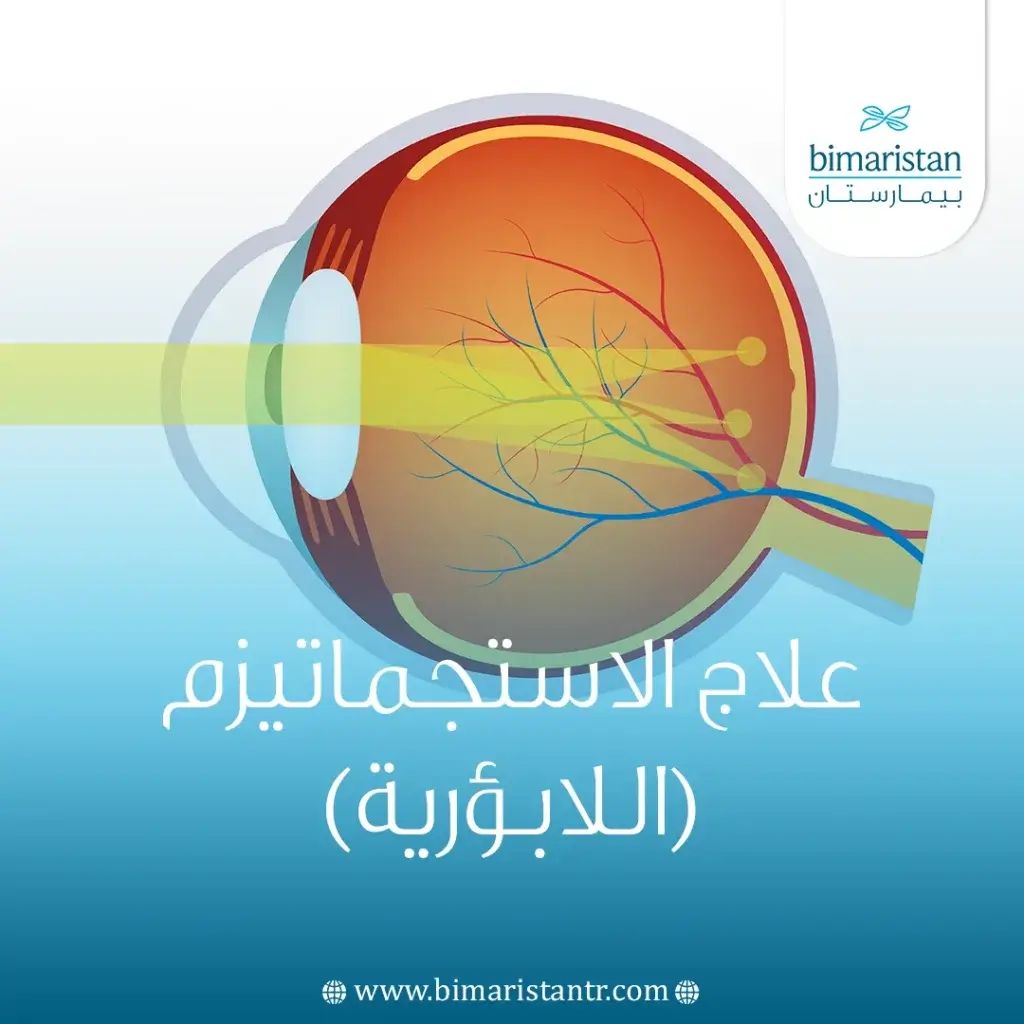الاستجماتيزم (اللابؤرية) هو اضطراب في الرؤية منتشر بشكل كبير في العالم، وإنَّ تشخيص وعلاج هذا الاضطراب قد تسارعت وتيرته بشكل كبير في تركيا.
لمحة عن العين والأوساط الكاسرة
لفهم المزيد عن الاستجماتيزم (اللابؤرية) يجب علينا فهم الجهاز الكاسر للضوء بشكل أكبر.
تحدث الرؤية عندما يدخل الضوء إلى العين eye من خلال بؤبؤ العين. وبمساعدة البُنى الأخرى المهمة في العين، مثل القزحية والقرنية، يتم توجيه كمية الضوء المناسبة نحو العدسة والتي توجه الضوء على الشبكية. تقوم القزحية بالتحكم بكمية الضوء الداخل للعين عبر تضييق أو توسيع الحدقة (البؤبؤ).
إنَّ البنى الكاسرة للضوء في العين هي: القرنية (cornea) و العدسة (lens), ولكل منهما سطحان أمامي وخلفي. القرنية هي الجزء الخارجي الدائري الشفاف من مقدمة مقلة العين، وهي خالية من الأوعية وذات توعية عصبية شديدة فهي حساسة للألم بشكل كبير.
أما العدسة فهي هيكل شفاف يقع خلف الحدقة داخل محفظة رقيقة شفافة. تماماً مثل العدسة الموجودة في الكاميرا، فإن العدسة الموجودة في العين تكسر (تحني) الضوء الوارد عليها ليسقط بالشكل الأمثل على شبكية العين.
تتكون شبكية العين من ملايين الخلايا البصرية المتخصصة المعروفة باسم العصي والمخاريط، والتي تعمل معًا لتحويل الصورة أو الضوء الساقط على الشبكية إلى طاقة كهربائية، والتي يتم إرسالها إلى القرص البصري ومن ثم يتم نقلها عبر نبضات كهربائية على طول العصب البصري ليتم معالجتها بواسطة الدماغ ونحصل على صورة الجسم بوضعيته وحجمه الصحيح.
ما هو الاستجماتيزم (اللابؤرية) Astigmatism؟
الاستجماتيزم (اللابؤرية) هو اضطراب عيني شائع أو خطأ في انحناء أي من الاوساط أو السطوح الكاسرة Refractive surface في العين يؤدي إلى رؤية مشوشة أو ضبابية أو غير موجهة.
تكون القرنية في الاستجماتيزم غير مستديرة أي أنَّ سطحها غير كروي توجد درجة معينة من الاستجماتيزم عند معظم الناس حتى إن لم يشعروا بخلل في الرؤية عندهم.

يوجد عدة طرق لتصنيف الأستجماتيزم بناءً على عدة عوامل:
حسب البنية المسؤولة عن الخلل
- اللابؤرية (الاستجماتيزم) القرنيّة: يكون الخلل هنا في أحد سطوح القرنية.
- اللابؤرية (الاستجماتيزم) العدسيّة: يكون الخلل هنا في أحد سطوح العدسة.
كما يمكن أن يكون الخلل في كلتا البنيتين وفي سطحهما الأمامي أو الخلفي.
بناءً على خطوط الطول أوالمحاور العينية
تتكون العين eye من عدة خطوط طول، للشرح أكثر نفترض أنَّ مقدمة العين عبارة عن وجه ساعة أو دائرة مركزها منتصف الحدقة، وكل خط طول يصل بين رقمين مختلفين (كالأقطار في الدائرة)، وإنَّ خطوط الطول الرئيسية هما خطان: أحدهما يصل بين الساعة الثالثة والساعة التاسعة والآخر يصل الساعة السادسة والساعة 12.
وفي الاستجماتيزم astigmatism يعد خطا الطول الأكثر تسطحاً والأكثر تحدباً (حدة) هما خطا الطول الرئيسيان Principle meridians.
يعد فهم خطوط الطول أمراً ضرورياً عند الحديث عن الأنواع المختلفة للاستجماتيزم. وحسب هذه الخطوط يقسم الأستجماتيزم إلى:
الاستجماتيزم المنتظم Regular astigmatism
في هذه الحالة تكون خطوط الطول الرئيسية متعامدة وتكون القوة الكاسرة للقرنية ثابتة في كل محور من المحاور المتعامدة، وهذا النوع هو الاكثر شيوعاً من أنواع الاستجماتيزم.
يمكن تقسيم اللابؤرية (الاستجماتيزم) المنتظمة بشكل أوسع إلى:
- الاستجماتيزم وفق القاعدة With-the-rule astigmatism: شائع بين الأطفال حيث تكون القوة الكاسرة لخط الطول العمودي أكبر ويكون هو الأكثر تحدباً (حدةً) ويظل قريباً من 90 درجة.
- الاستجماتيزم ضد القاعدة Against-the-rule astigmatism: يظل خط الطول الأفقي قريباً من 180 درجة وتكون قوته الكاسرة أكبر من المحور العامودي، الاستجماتيزم ضد القاعدة أمر شائع عند كبار السن.
- الاستجماتيزم المائل Oblique astigmatism: يتم تشخيص الاستجماتيزم المائل إذا لم تكن خطوط الطول الرئيسية عند 90 درجة أو 180 درجة، هنا، شكل مقلة العين يشبه كرة القدم الأمريكية المائلة، حيث تقع خطوط الطول الرئيسية بين 30 و 60 درجة و 120 درجة و 150 درجة.
كما يمكن تقسيم الاستجماتيزم المنتظم بناءً على خلل الرؤية الذي يحدث (والناجم عن اختلاف القوة الكاسرة في المحاور المتعامدة وليس في المحور نفسه):
- الاستجماتيزم المنتظم البسيط Simple regular astigmatism: يقصد به أن أحد محوري القرنية يجلب بؤرة الصورة على الشبكية بينما المحور الآخر يجلبها أمام أو خلف الشبكية، أي أن هذا النوع من الاستجماتيزم غير مصحوب بقصر النظر ولا بطوله.
- الأستجماتيزم المنتظم المركب Compound regular astigmatism: في هذا النوع يعاني المريض من مد النظر أو قصر النظر، حيث يقوم كلا خطي الطول بتركيز بؤرة الصورة أمام (حسر النظر) أو خلف (مد النظر) الشبكية.
- الاستجماتيزم المنتظم المختلط Mixed regular astigmatism: وفي هذه الحالة يقوم أحد المحوران بتركيز بؤرة الصورة أمام الشبكية والآخر خلف الشبكية.
الاستجماتيزم غير المنتظم Irregular astigmatism
تكون خطوط الطول الرئيسية غير متعامدة وتكون القوة الكاسرة للقرنية مختلفة على طول المحور الواحد. وهي غير شائعة مقارنةً بالنوع المنتظم ونراه غالبا عند أذيات العين الخارجية نتيجة الرضوض أو العمليات الجراحية.
نلاحظ أنً تصينف اللابؤرية (الاستجماتيزم) معقد ويمكن القول أنَّ لكل مريض تصنيف خاص به ولكن هذه التصنيفات وضعت لتسهيل الأمور ووضع أرضية للخطة العلاجية ومن ثم التعديل عليها.
أسباب اللابؤرية (الاستجماتيزم) Causes
لحد الآن لا يعرف الأطباء سبب اختلاف شكل القرنية أو العدسة وتحدبهما عند الناس في الحالة الطبيعية. وكذلك في حال الاستيجماتيزم السبب غير معروف بشكل واضح. يمكن ان تكون الحالة موجودة عند الولادة وذلك يشير للدور الكبير للوراثة في هذا الاضطراب.
قد ينجم الاستجماتيزم أيضاً عن إصابة في العين, جراحة في العين (كجراحة زرع عدسة صنعية)، أو عن حالة تُعرف باسم قرنية مخروطية keratoconus، والتي لا تؤدي إلى ترقق القرنية فحسب، بل يصبح شكلها مخروطي وتؤدي إلى خلل انكساري.
تؤدي هذه الحالة إلى درجة شديدة من الاستجماتيزم، مما يتسبب في ضعف النظر عند المريض وهذا الضعف لا يمكن تصحيحه بشكل تام باستخدام النظارات، ويحتاج إلى زرع القرنية في كثير من الحالات.
كما يمكن ان تحدث اللابُؤْرِيَّة (الاستيجماتيزم) بسبب ضغط الجفون على القرنية أو الفرك الدائم للعيون (يفضل عدم فعل ذلك) ولا تنتج كما يظن الكثيرون من تقريب الكتاب من العيون أثناء القراءة أو من القراءة في ضوء خافت.
يترافق الاستجماتيزم (اللابؤرية) (حرج البصر) عادة مع قصر النظر (nearsightedness) أو مد النظر (farsightedness) ويسمَّون معاً باضطرابات سوء الانكسار.
اعراض الاستجماتزم (اللابؤرية)
تتباين أعراض الاستجماتيزم وتختلف باختلاف شدة و أنواع الاستجماتيزم Astigmatism وتشمل الأعراض غالباً:
- ضبابية الرؤية Blurred vision أو تشوهها عند كل المسافات.

- الصداع.
- صعوبة في الرؤية في الليل Night Vision (صعوبة القيادة مساءً).
- تهيج و إجهاد عيني Eyestrain.
- التحديق الطويل حتى توضح الرؤية.
- يؤثر الاستجماتيزم في عمق الرؤية وتحديد البعد و وضوح الشكل الحقيقي ل الأشياء ويمكن أن يشعر المريض بعدم التوازن.
يمكن أن يسبب الاستجماتيزم عند الأطفال ما يعرف بالعين الكسولة.
طرق تشخيص الاستجماتيزم (اللابؤرية) في تركيا
تطورت طرق تشخيص الاستجماتيزم في تركيا بشكل كبير وإنَّ الفحوصصات الدورية التي تجرى ساعدت الكثير من الناس على حل مشكلة غفل عنها الكثيرون.
هذا الأمر له أهمية خاصة عند الاطفال حيث لا يشتكون من خلل في الإبصار إما لأنهم لا يستطيعون أو أنهم يظنون أنها الحالة الطبيعية فمن الضروري بل من الحتمي أن يتم إجراء فحوات دورية لديهم لأن الاستيجماتيزم يؤثر على درجة إنتاجهم ومشاركتهم وتفاعلهم في المدرسة والمنزل وعلى تحصيلهم العلمي.
كما يجب التحري عند المراهقين من وجود مرض (القرنية المخروطية keratoconus). تقوم الاختبارات المختلفة بتحديد درجة الاستجماتيزم وماهي الطريقة الأمثل للعلاج أو العدسات التي يجب استخدامها.
يقوم الطبيب في البداية بإجراء فحص عيني روتيني وفي حال وجود خلل يمكن اللجوء لطرق تشخيص أكثر دقة. من الاختبارات أو الأجهزة المستخدمة:
اختبار تقييم حدة البصر Visual acuity test
في هذا الاختبار سيطلب منك الطبيب قراءة الحروف أو تحديد جهتها من مخطط على مسافة محددة لتحديد مدى قدرتك على رؤية الحروف.
اختبار الانكسار (كيف تكسر العين الضوء) Refraction test
اختبار بصري يستخدم آلة تسمى الكاسر (phoropter). يحتوي الجهاز على عدسات زجاجية تصحيحية متعددة بنقاط قوة مختلفة.
سيطلب منك الطبيب قراءة مخطط أثناء النظر في العدسات التي يغيرها الدكتور حتى تناسب بصرك. سيتم في النهاية تحديد أي عدسة تصحح رؤيتك و الاستجماتيزم بالشكل الأفضل.
مقياس انحناء القرنية Keratometer
يقوم بقياس درجة انحناء القرنية curvature of the cornea وفيه يتم تركيز الضوء على القرنية ويقيس الضوء المنعكس وكيفية انعكاسه لمعرفة انحناء القرنية.
هذا الاختبار مهم للحصول على العدسات المناسبة والتفريق بين الاستجماتيزم الاعتيادي و الاستجماتيزم الناجم عن المرض.
طبغرافيا القرنية Corneal Topography
وهو يساعد في الحصول على معلومات أكثر حول تضاريس القرنية وانحناءاتها وشكلها لفهم استجماتيزم العين بشكل مفصل أكثر واختيار العلاج المناسب للاستجماتيزم.
للاستفسار عن المزيد من طرق التشخيص أو أعراض الاستجماتزم لا تتردد بالتواصل معنا، مركز بيمارستان عائلتك في تركيا.
علاج الاستجماتزم (اللابؤرية) في تركيا
تطورت في الآونة الأخيرة طرق علاج الاستجماتيزم في تركيا وتنوعت الأجهزة والطرق المستخدمة وذلك لتناسب الأنواع المختلفة من عيوب الابصار واختلاف درجات الاستجماتيزم وشدة الخلل والأعراض عند المصابين به.
يمكن أن تكون الحالة خفيفة وغير عرضية عندها لا تتطلب أي معالجة، كما يمكن للأعراض أن تكون مزعجة للمريض وتؤثر على حياته اليومية وإنتاجه وعندها يجب مراجعة الطبيب لتحديد هل المريض مصاب بالاستجماتيزم أم لا وطريقة علاجه.
إنَّ علاج الاستجماتيزم الرئيسي هو العدسات المُصحِّحة lenses سواءً كانت كنظارات eyeglasses أم كعدسات لاصقة contacts حيث تصحح هذه العدسات غالبية حالات الاستجماتيزم.
كان يُظن أن العدسات اللاصقة المستخدمة في علاج الاستجماتيزم هي العدسات الصلبة rigid contacts لكن الآن طوُّر نوع آخر من العدسات يدعى بالعدسات الحيدية Toric contacts وهي عدسات لينة صغيرة.
العدسات العادية لها قوة واحدة فقط، لكن العدسات الحيدية Toric لها اثنتان: واحدة للرؤية عن بعد والأخرى للاستجماتيزم. تبقى العدسات اللاصقة الصلبة الخيار الأفضل في حالات الاستجماتيزم الشديدة severe astigmatism condition.
في العدسات اللاصقة يكون مجال الرؤية أوسع مقارنة بالنظارات كما تكون مناسبة أكثر في الحياة العملية لكن لها عدة مساوئ كالإنتانات بسبب إهمال قواعد النظافة والصحة ويمكن أن لا تناسب جميع المرضى.
من طرق العلاج الأخرى:
تقويم القرنية Orthokeratology
ويطلق عليها اختصارا ortho-k، يقوم بها الطبيب بوصف عدسات لاصقة صلبة يلبسها المصاب بالاستجماتيزم عند النوم وتقوم هذه العدسات بتقويم شكل القرنية.
هذه العملية لا تهدف للعلاج الشافي للاستجماتيزم إنما علاج مؤقت ويمكن أن تعود المشكلة في حال التوقف عن استخدام هذه العدسات.
الجراحة
يوجد عدة طرق جراحية لعلاج الاستجماتيزم غالبها باستخدام الليزر وهي في الغالب علاجات نهائية شافية لكنها قد تحوي بعض المشاكل والاختلاطات، ومن هذه العلاجات:
الليزك LASIK
أو ما يسمى laser in situ keratomileusis، يتم إنشاء سديلة صغيرة في القرنية باستخدام نبضات صغيرة وسريعة من الليزر، ثم يتم ثني السديلة للخلف ويتم استخدام الليزر الموجه لإعادة تشكيل القرنية. بعدها يتم إعادة السديلة إلى مكانها، حيث تلتصق بشكل طبيعي.
وقد تطور علاج الاضطرابات العينية بالليزر بشكل كبير في تركيا وحققت نسب عالية من الشفائية والنجاح.

استصال ظهارة القرنية التصحيحي PRK
Photorefractive keratectomy وفيها يتم إزالة الطبقة الظهارية السطحية من القرنية في عين المريض بواسطة فرشاة أو أداة طبية معينة ثم يتم توجيه الليزر لإعادة تشكيل القرنية.
بعد الانتهاء من العملية يقوم الطبيب بوضع عدسة لاصقة فوق القرنية ريثما تنمو ظهارتها من جديد.
تشطيب القرنية RK
تم الاستغناء عن هذه العملية بالعمليات السابقة نظراً لاختلاطاتها الكثيرة ونتائجها غير الدقيقة.
قد نحتاج إلى زراعة قرنية جديدة في حال تأذيها بشكل كبير وهو ما أُسهِب عنه في زراعة القرنية في تركيا. يمكن إجراء هذه العمليات للمرضى ذوي الصحة الجيدة والمؤهلين للعمل الجراحي.
يجب على الجميع القيام بفحوص دورية لضمان صحة أهم عضو حسي عندهم وتصحيح أي خلل فيه. راجع أخصائي مركز بيمارستان وتواصل معهم، فيمكن أن يكون لديك استمجاتزم وانت لا تشعر.
المصادر:


